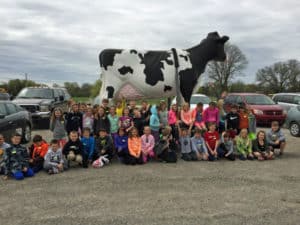
By Jennifer Fairfield, owner Garden Mill
The biggest problem with the weather last month is that it made gardening difficult.
Heck, it made planning for gardening difficult. I had planned to get most of my warm-weather plants into the garden sometime in the last week, but the weather made me hesitant. Temps that cold can shock our warm-weather lovers – like tomatoes, peppers, and eggplant – which slow down their growth.
So, I decided to wait to plant them. And now I’m super behind. If like me, you are a little behind in your garden chores, here’s the list of to-dos to catch up on:
Vegetable Garden:
If you haven’t gotten your warm-weather vegetable and herb plants in yet, you should do that ASAP. It looks like we should be safe to do so now, as there is no indication that temps will drop below 50 at night in the foreseeable future.
Overnight temps below 50 for any extended time are not good for most of our garden favorites, which has made getting them into the garden up until now tricky. But waiting much longer is also problematic, as many of them need all summer to really produce. It’s really getting too late to even think about starting many plants from seed now – there won’t be enough time for them to grow to maturity at this point – so get plants that have already been started.
This is true for tomatoes, peppers, eggplants, and squash, and even some cucumbers, though there may be time enough for seeds of those if you hurry. If you are considering planting seeds, check the seed packet for the “days to maturity.” That’s how long it takes from the time the seeds first come out of the ground to when the plants will begin to produce.
Since our average first frost is around Oct. 5, we have just over four months from today for growing. If a tomato seed takes 10 days to germinate and 90 days to maturity, then you won’t even begin to see tomatoes until just before it starts to frost, let alone get many tomatoes.
Stake or cage your tomato plants when you are putting them in to help ensure that you don’t damage the roots trying to get them in later. Peppers and eggplants also often do better when staked or supported with cages, so put the stakes/cages in when you put the plants in.
The other thing to do as soon as you plant your tomatoes, squash, and cucumbers (and really everything else), is to begin a program of spraying your plants with fungicide. All of these plants are susceptible to many types of diseases, and the only way to deal with these issues is through prevention.
Once the diseases set in, you can slow them down a little (sometimes), but you can’t cure them. So, start spraying early, and keep doing it. Follow directions on the fungicide’s packaging to determine how much and how often. If you’re not sure what to use, come talk to us – we have a few options, depending on what you are growing.
Diseases are one of the biggest reasons people don’t get as much from their gardens as they hope. Treating with fungicide early and continuing throughout the season will make a big difference in how much you get to harvest.
If you haven’t already, plant some bush bean seeds now, and for the next few weeks. Bush beans produce in one big flush over a week or two, so planting some every couple of weeks into mid to late June will ensure that you have a continuous harvest all the way up to first frost. You can also plant successions of beets, carrots, dill, parsley, and cilantro through the end of July to ensure a prolonged harvesting season. You can still plant pole beans now, but don’t delay too much longer. Unlike bush beans, pole beans produce throughout the season – all the way to frost – but they need a little longer to start producing, so get them going now.
Cabbage and broccoli can be started at the end of the month or early July for fall harvest. Plant seeds directly into the garden, or start them indoors and transplant the seedlings into your garden by late August. They’ll be ready to eat by late September or early October. To protect these cool-weather loving plants from the heat of summer, try planting them in a shady part of your garden or in the shade of other plants, or use shade covers to keep them cool.
Keep your gardens weeded. Pulling weeds out when they are small makes it much easier to get the whole thing, and keeps the weed from spreading as easily. I try to fit in a little bit of weeding at a time, while I’m doing other things, such as planting beans – that way I don’t notice that I’m actually working at weeding.
Flower Gardens, Trees and Shrubs:
If you’re hoping to grow flowers and haven’t gotten those seeds or plants in the ground yet, don’t wait much longer. If you’re putting in plants, don’t forget to mulch around them when you plant. Mulch is just about the most important thing you can do for your plants – it helps keep moisture in, maintains moderate soil temperatures, and keeps weeds down.
If planting seeds, mulch as soon as the plants are big enough not to get crushed by the mulch and keep them well-watered in the meantime – whenever Mother Nature isn’t providing at least an inch per week, you really need to do so yourself. Invest in a good rain gauge to help you keep track of the amount of rain we get – it helps take the guesswork out of the whole watering thing. Attaching timers to hoses and sprinklers can be a life-saver (and water-saver, too).
Be sure to pay extra attention to anything you have just planted (or are going to plant) this spring. Newly planted trees, shrubs, and perennials need to be well-watered as they are getting established, which can take as much as three years, in some cases. They aren’t as good at taking up water from the soil as plants that have been there for longer, so you need to make sure that you are keeping the soil properly hydrated. With how dry it’s been around here, this is going to be really important going into the heat and drought of our typical summer.
Water your container plants regularly. Soil in containers dries out much more quickly than in the ground, even more so if the containers are in the sun and exposed to the wind. Also, don’t forget that plants in containers need to be fertilized on a regular basis, mostly because you will be flushing out what fertilizer is in the soil with all the water you are giving them.
Just be careful not to fertilize more than is suggested on the label of the product you are using – chemical fertilizers can cause “burn” on your plants when over-applied. Fertilizer burn happens because most chemical fertilizers contain salts, which draw the moisture out of your plants. Slow-release and organic fertilizers can help to prevent fertilizer burn.
Speaking of containers, indoor plants can benefit from spending the summer outdoors, but be sure to place them in a spot where they will be protected from winds and where they will get some filtered sun throughout the day. Houseplants are not used to the direct sun, and can be easily scorched if they are not given a little shade. They will also dry out more quickly outdoors than in, so be sure to increase your watering schedule. And don’t forget to fertilize them.
Are you planning to do some planting of trees, shrubs, and perennials yet this year? June can be a good month to do that, especially if you or Mother Nature are sure to keep them well-watered. If you are looking for some ideas of what to plant, consider planting natives that will attract bees, butterflies, and other beneficial insects. Many bees that are native to Michigan are in danger of extinction, and Monarch butterfly populations have been declining for decades.
Planting native plants that provide sources of food for larvae and adults can help them. Some of the best plants native to Michigan for bees and butterflies include penstemon, coneflower, asters, and milkweed. The MSU Extension has a great brochure for plants to attract bees and other beneficial insects, and the Michigan DNR offers this table as a reference for plants to consider for butterfly gardens and to attract hummingbirds.
There’s also a great article from Mother Earth News about attracting beneficial insects to you yard that includes an exhaustive list of plants (both annual and perennial). And consider planting some herbs in your flower beds for butterflies. Dill, fennel, and parsley are host plants for the larvae of black swallowtail butterflies, and the flowers also provide nectar to adults.
Birds:
I’ve had a number of people tell me they haven’t been seeing as many hummingbirds at their feeders this year, and they can’t figure out why. My feeders have been pretty busy, and I haven’t seen anything about any issues in Michigan for them, so I’m not sure what’s keeping them away from some feeders. You can ensure that you’ll get more of the jeweled beauties coming to your yard by keeping your feeders clean and full (change the nectar at least once per week at this time of year, and more frequently as the temperatures go up).
Another way to ensure that you attract more hummers is to plant flowers that they like near your feeders. The list of flowers hummers are most attracted to includes cardinal flower, lupine, columbine, and bee balm.
Water is just as important to your backyard birds as it is to your plants. Birds need good sources of clean water for drinking and bathing. If you don’t already have one, consider putting out a birdbath for your feathered friends. If you have one, make sure you keep it cleaned out and filled with water. Replacing the water every day will be as beneficial to you as the birds – it helps keep mosquitoes from laying their eggs in the water. Another option is to keep the water moving. Birds love moving water, and mosquitoes don’t.
Adding a fountain or “water wiggler” to the birdbath will make your birds happy and help to reduce the number of mosquitoes.
At this time of year, birds are busy raising their young. While you are out in your yard and garden, keep an eye out for baby birds so that you don’t inadvertently harm them. Whether or not you should do anything to help a baby bird you find in your yard depends on a number of things.
Refer to this information from the Cornell Lab of Ornithology to help you decide what to do.












